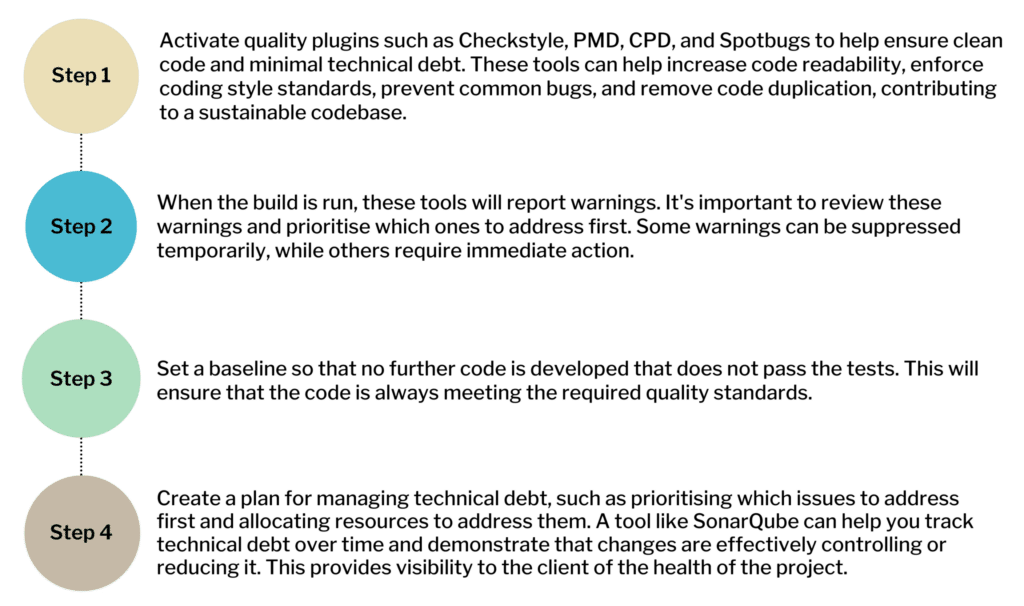Software development projects can easily be derailed or delayed by scope creep, context switching, and changes to the coding team. Having worked on successful and challenging IT projects, I have learned a few tips and strategies to ensure project success. Recently, my team accomplished a particularly effective project, despite the challenges of a large, hybrid team spread across different locations and time zones. In this article, I will share our top 10 recommendations for operating with best practices to ensure quality coding, programming, and product delivery. By implementing these strategies, you can avoid common pitfalls and achieve your project goals on time and with high quality results.
10 Project Team Best Practices
1. Establish coding standards and guidelines:
The first crucial step is to establish a set of coding standards and guidelines for the team to follow from the outset. The technical lead needs to be firm and reject code when it is not up to standard. Naturally this can add time to the build so it is important to communicate the benefits around following guidelines such as consistency in the codebase and ensuring new developers or support engineers can come up to speed quickly and easily in the future.
2. Code testing and review:
To ensure code quality, functionality and early issue detection, developers should write new tests for each code change using Test Driven Development (TDD) principles. These new tests should be integrated with existing tests to prevent code coverage drops and act as the first level of regression testing. We also set up a code review process where team members review each other’s code to ensure it meets standards, is readable, maintainable, and bug-free. Regular refactoring and optimization keep the code maintainable and performant. This process, in use with usual validation/QA teams, maintains confidence and reduces the risk of issues in the codebase.
3. Use version control:
Use a version control system like Git to keep track of code changes and ensure collaboration among team members. This is a must-have as you cannot develop solutions collaboratively without one.
4. Monitor Performance:
It helps to also implement monitoring and performance analysis tools to ensure the system is running efficiently and identify any bottlenecks. The process and tools used to deliver the project should be regularly reviewed and updated to improve the quality of code and delivery.
5. Encourage knowledge sharing and open communication:
Effective and regular communication across business stakeholders and the project delivery team is essential to understand business drivers, negotiate realistic time frames, budget estimates and gain awareness of the client’s measures of success. Encourage team members to share their knowledge and best practices to improve the overall quality of the codebase. It creates a sense of “being on the same page” and minimises potential risk/error or missed expectations.
During our project the team collectively worked with an unapologetic and confident attitude, and ‘owned’ the code they were working on which resulted in great trust and flexibility from the client. Having a proactive approach to resolving technical debt allowed us to keep it maintained. Creating clear and extensive documentation, especially in regards to infrastructure was a big advantage. It reduced bugs, tech debt, and headaches down the track while allowing for new additions to the team to get started as we had defined steps required for project setup.
Need a second pair of eyes to assess the current state of your platform?
6. Use Pair-Programming:
Encourage pair-programming and collective code ownership for new features or bug fixing. While traditionally this involves two developers sharing one computer, with remote work becoming so common, alternative solutions are necessary. In our case, we found success using the “Code with Me” feature in IntelliJ, which allows multiple developers to work together on the same codebase remotely. This tool enables real-time collaboration and knowledge sharing, as developers can interact directly using their own keyboard and mouse, without the need for screen sharing or voice-only communication. This approach proved to be a valuable tool for remote pair programming, resulting in reduced human error and risk.
7. Have a well-defined process for decision making and problem-solving:
A defined and meticulous process for decision-making creates highly efficient work practices. Know when to divide and conquer by splitting teams into squads, create minimal context switching if possible and determine clear objectives and specifications will make for a smoother experience. Implementing risk management is also a must – confronting risks and informing clients early about possible setbacks will better prepare both parties.
8. Appoint confident project lead to establish trust between teams:
Our greatest support in this recent project was our Project Lead who could speak the language of both the tech team and the C-Suite, and was able to communicate updates at a high level, building rapport and confidence with our client. Our PL completely understood where the dev team was at a given moment, and was able to update and assure the client. It helped explain and provide adaptability around the broader stakeholder vision – it set very clear expectations. Establishing a trusting relationship between the two teams is in my experience paramount to a successful project and ongoing client relationship.
9. De-brief/Review:
Create a post release review or ‘lessons learned’ document to reflect on what worked well and what didn’t will help cement key lessons and help with future projects’ success.
10. Test, test, test:
To further improve the quality of code and ensure successful project delivery, the following tools can be used. Performance testing can help identify areas of the application that may need optimization to improve its speed and efficiency. Load testing can help assess the application’s ability to handle high traffic and loads. Application security scanning tools such as Veracode can analyse the code and identify potential security issues or breaches, helping to ensure that the application is secure and compliant with industry standards. These tools can provide valuable insights and help mitigate potential risks, ultimately leading to a higher quality end product.
Key Steps for Quality Code Development



